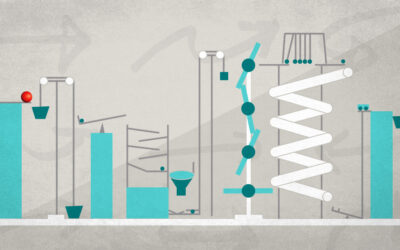At the recent Winter NAMM convention in Anaheim California, the MIDI Manufacturers Association voted to formally adopt the MIDI 2.0 specification that’s been in development for over a decade. Art+Logic has been involved with this effort for the past several years as part of the group of companies working to validate MIDI 2.0 during its development and refinement by creating prototype implementations of it and connecting those prototypes together to make sure that things perform as well in reality as they do on paper.
What does this mean in the short term? Companies that make hardware and software for musicians will need to become conversant with the additions to MIDI 1.0 (which has been exceptionally stable for the past 38 years!) and determine how their existing product lines might need to change to make use of the expanded capabilities in MIDI 2.0, as well as considering the ways that entire new products and types of products might be invented now. Musicians shouldn’t expect to be able to buy much equipment that has complete MIDI 2.0 support for a while; we also need to wait for platform vendors like Apple, Microsoft, and Google to add new Application Programming Interfaces to their operating systems so developers will be able to build these new software products.
Longer term — this is an opportunity to bring the capabilities of electronic music systems from the 80s into the 21st century and compelling new creative tools that are both radically more expressive and musical as well as becoming easier to connect together and configure.
Last fall I spoke with MusicRadar’s James Russell in more depth on what’s coming and some likely impacts on musicians in the next few years:
What is MIDI 2.0, and what does it mean for musicians and producers?
Here is the statement released by the MMA:
Introduction to MIDI 2.0™
Back in 1983, musical instrument companies that competed fiercely against one another nonetheless banded together to create a visionary specification—MIDI 1.0, the first universal Musical Instrument Digital Interface. Nearly four decades on, it’s clear that MIDI was crafted so well that it has remained viable and relevant. Its ability to join computers, music, and the arts has become an essential part of live performance, recording, smartphones, and even stage lighting.
Now, MIDI 2.0 takes the specification even further, while retaining backward compatibility with the MIDI 1.0 gear and software already in use. Here’s why MIDI 2.0 is the biggest advance in music technology in decades.
MIDI 2.0 Means Two-way MIDI Conversations
MIDI 1.0 messages went in one direction: from a transmitter to a receiver. MIDI 2.0 is bi-directional and changes MIDI from a monologue to a dialog. For example, with the new MIDI-CI (Capability Inquiry) messages, MIDI 2.0 devices can talk to each other, and auto-configure themselves to work together. They can also exchange information on functionality, which is key to backward compatibility—MIDI 2.0 gear can find out if a device doesn’t support MIDI 2.0, and then simply communicate using MIDI 1.0.
Higher Resolution, More Controllers and Better Timing
To deliver an unprecedented level of nuanced musical and artistic expressiveness, MIDI 2.0 re-imagines the role of performance controllers, the aspect of MIDI that translates human performance gestures to data computers can understand. Controllers are now easier to use, and there are more of them: over 32,000 controllers, including controls for individual notes. Enhanced, 32-bit resolution gives controls a smooth, continuous, "analog" feel. New Note-On options were added for articulation control and precise note pitch. In addition, dynamic response (velocity) has been upgraded. What’s more, major timing improvements in MIDI 2.0 can apply to MIDI 1.0 devices—in fact, some MIDI 1.0 gear can even "retrofit" certain MIDI 2.0 features.
Profile Configuration
MIDI gear can now have Profiles that can dynamically configure a device for a particular use case. If a control surface queries a device with a "mixer" Profile, then the controls will map to faders, panpots, and other mixer parameters. But with a "drawbar organ" Profile, that same control surface can map its controls automatically to virtual drawbars and other keyboard parameters—or map to dimmers if the profile is a lighting controller. This saves setup time, improves workflow, and eliminates tedious manual programming.
Property Exchange
While Profiles set up an entire device, Property Exchange messages provide specific, detailed information sharing. These messages can discover, retrieve, and set many properties like preset names, individual parameter settings, and unique functionalities—basically, everything a MIDI 2.0 device needs to know about another MIDI 2.0 device. For example, your recording software could display everything you need to know about a synthesizer onscreen, effectively bringing hardware synths up to the same level of recallability as their software counterparts.
Built for the Future.
MIDI 2.0 is the result of a global, decade-long development effort. Unlike MIDI 1.0, which was initially tied to a specific hardware implementation, a new Universal MIDI Packet format makes it easy to implement MIDI 2.0 on any digital transport (like USB or Ethernet). To enable future applications that we can’t envision today, there’s ample space reserved for brand-new MIDI messages.
Further development of the MIDI specification, as well as safeguards to ensure future compatibility and growth, will continue to be managed by the MIDI Manufacturers Association working in close cooperation with the Association of Musical Electronics Industry (AMEI), the Japanese trade association that oversees the MIDI specification in Japan.
MIDI will continue to serve musicians, DJs, producers, educators, artists, and hobbyists—anyone who creates, performs, learns, and shares music and artistic works—in the decades to come.



